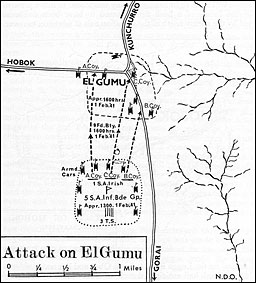
14
The Taking of Gob wen and Kismayu
When Brigadier Pienaar flew from Arbo to Garissa on 3 February 1941, to discuss with Major-General Godwin-Austen the question of a suitable successor to Lieutenant-Colonel McMenamin as Commanding Officer of the Natal Carbineers, owing to his ill-health, the 1st SA. Brigade Group, after the reconnaissance in force towards Moyale, was disposed with 1st Transvaal Scottish (less one company) at Digh Merer with a detachment of 1st Field Company, S.A.E.C, 5th Light Anti-Aircraft Battery, S.A.A., 2nd Anti-Tank Battery, S.A.A. and 10th Field Ambulance, S.A.M.C. The Natal Carbineers and detachments of 1st Field Company, S.A.E.C. and 10th Field Ambulance, S.A.M.C. were in the process of taking over from a company of the Transvaal Scottish at Gerille, just across the Somaliland border due east of Arbo. In each case the battalions were served by their usual sections of 1st or 2nd Reserve Motor Transport Companies, which had virtually become integral parts of the motorized infantry units. The rest of 1st S.A. Infantry Brigade Group was a few miles inside the frontier, at Gurati, preparing to move back to Arbo. Minor instructions telegraphed by Brigadier Pienaar during his visit to Garissa re-routed the main body of the Natal Carbineers also to Gurati, with only 'C' Company being left at Gerille.1
The Brigade Commander's visit to 12th African Division's Headquarters coincided with the South African Air Force's destruction of nine Italian aircraft in one day,* thus gaining an ascendancy in the air which they were never to lose in East Africa. It was a propitious moment for the launching of an offensive and on 5 February, while the last units of his Brigade Group left at Arbo were moving forward to Gurati and a platoon of No. 3 S.A. Armoured Car Company was on its way to Beles Gugani to join 22nd East African Brigade, Brigadier Pienaar and his staff were flown down to Aligabe to pick up Brigadier C. C. Fowkes of 22nd East African Brigade. Then they flew on to Garissa, where they met Brigadier C. E. M. Richards of 24th Gold Coast Brigade, for a conference with Major-General Godwin-Austen, who revealed the details of General Cunningham's plan for crossing the Juba and taking Kismayu.
Absolute secrecy was the essence of the operation and, as in the case of General Cunningham's conference with his divisional commanders, no written orders were issued by 12th African Division, except a general
* See also page 84.



